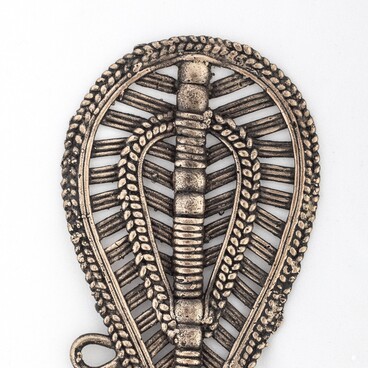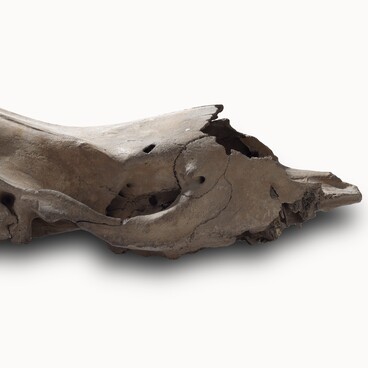The Kursk Regional Museum of Archaeology presents a monument of the Scythian culture — a pyramid-shaped altar made of clay blocks and a miniature vessel. It was found in 1961 during the excavations of the Uspensky settlement in the Kursk region, led by the archaeologist Anna Yepifanovna Alikhova. The altar was the remainder of a cult structure — a partially destroyed rounded adobe platform with traces of fireplaces, in the center of which there was a pyramid built of 33 clay blocks with a small ornamented clay vessel on top.
The discovered sanctuary is to this day the only cult site of the early Iron Age on the territory of the modern Kursk region. However, there are some finds of small metal pendants in the form of pyramids consisting of several rows of convex circles. It is possible that these pendants are symbolic images of altars. Similarly, clay blocks with finger-embossed ornaments, as well as clay imitations of grains and fruits are often found on the Scythian monuments located in the forest-steppe zone and, in particular, in the territory of the modern Kursk Region. All these objects are attributed by researchers to the votive group, i.e. they are directly related to religious offerings.
Since the Scythians did not have a writing system, the main sources for the reconstruction of the Scythian religion are brief testimonies of ancient authors, including their records of Scythian mythology, burial rites and objects of worship, as well as the remains of religious buildings and objects that were related to the Scythians’ religious beliefs.
It is worth noting that the Scythoid population groups in different geographical regions had notable differences with regard to the use of objects of their material cultures. Thus, the religious beliefs of the forest-steppe population differed from the beliefs of the steppe Scythians and the “royal” Scythians who inhabited the Black Sea region. Materials from the excavations of the Belsky fortress, a Scythian site of the late 8th — early 3rd century BC, located in the Poltava region of Ukraine, can give an idea of what a large religious center of the left-bank forest-steppe looked like. The study revealed cult complexes of three cylindrical altars and three large pits. In addition, many other objects of cult purpose were found: lamps, clay cakes and models of grains, zoomorphic and anthropomorphic statuettes.
The discovered sanctuary is to this day the only cult site of the early Iron Age on the territory of the modern Kursk region. However, there are some finds of small metal pendants in the form of pyramids consisting of several rows of convex circles. It is possible that these pendants are symbolic images of altars. Similarly, clay blocks with finger-embossed ornaments, as well as clay imitations of grains and fruits are often found on the Scythian monuments located in the forest-steppe zone and, in particular, in the territory of the modern Kursk Region. All these objects are attributed by researchers to the votive group, i.e. they are directly related to religious offerings.
Since the Scythians did not have a writing system, the main sources for the reconstruction of the Scythian religion are brief testimonies of ancient authors, including their records of Scythian mythology, burial rites and objects of worship, as well as the remains of religious buildings and objects that were related to the Scythians’ religious beliefs.
It is worth noting that the Scythoid population groups in different geographical regions had notable differences with regard to the use of objects of their material cultures. Thus, the religious beliefs of the forest-steppe population differed from the beliefs of the steppe Scythians and the “royal” Scythians who inhabited the Black Sea region. Materials from the excavations of the Belsky fortress, a Scythian site of the late 8th — early 3rd century BC, located in the Poltava region of Ukraine, can give an idea of what a large religious center of the left-bank forest-steppe looked like. The study revealed cult complexes of three cylindrical altars and three large pits. In addition, many other objects of cult purpose were found: lamps, clay cakes and models of grains, zoomorphic and anthropomorphic statuettes.



